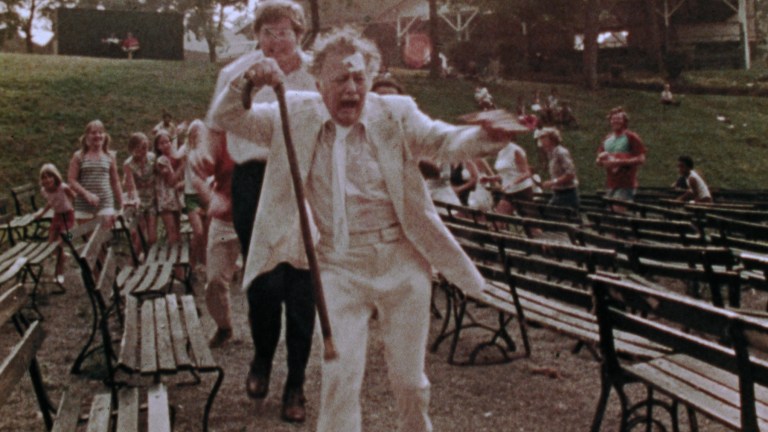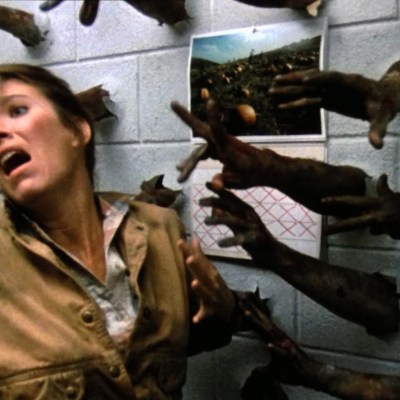The Amusement Park: How George Romero’s Long Lost Film Was Found
The Amusement Park, a genuinely disturbing and long buried George A. Romero film, has come back from the cinematic graveyard.

In 1968, George A. Romero directed Night of the Living Dead, a tiny independent horror film that went on to change the face of its genre and make a permanent mark on film history itself. Five years later, Romero’s two decidedly un-Dead-like follow-ups—There’s Always Vanilla (1971) and Season of the Witch (1972)—had already vanished quickly into obscurity. He was still several years away from directing Dawn of the Dead and again becoming a worldwide horror sensation.
Perhaps simply looking to put food on the table while getting his next project (The Crazies) up and running, Romero was receptive when approached by the Lutheran Society, who wanted to create an educational film about society’s poor treatment of the elderly. With a script by Walton Cook (one of the rare Romero projects he did not write himself), Romero’s only work for hire, called The Amusement Park, was apparently so disturbing that the Lutheran Society never released it.
“I know a lot of people have been using the word ‘lost,’ but it wasn’t really quite lost,” says Romero’s widow, Suzanne Desrocher-Romero, about the film, which premieres this week, 48 years after it was made, on the Shudder streaming service. “It was more about it being shelved, I guess, maybe. It really wasn’t a film. It was a PSA. It was meant to be shown in [Lutheran Society] community centers.”
Either way, the film was all but forgotten until a 16mm print turned up in 2017, not long before George Romero passed away. It’s since played as part of a tribute to Romero at the Torino Film Festival.
“I had been basically his gatekeeper since 2005, and I had never heard him mention this film ever in any of his interviews,” says Suzanne. “A friend of ours, Julia, who is a programmer for the Torino Film Festival, had the film. She gave me the 16, which I put in my office, and a DVD.”
Suzanne says she and her husband watched it perhaps “three or four weeks” before George’s death in July 2017. “I have to say, I was gobsmacked,” Suzanne says. “First of all, it’s even hard to describe. It’s so unique, it’s edgy, it’s still relevant. It still has Romero all over it. I said to him, ‘What the heck? You never mentioned this.’ He goes, ‘Well, it was a community thing. It was nothing.’”
The 53-minute film stars Lincoln Maazel, who would later show up in Romero’s 1977 cult vampire film, Martin. After addressing the viewer directly in a brief introduction to explain the movie’s premise, Maazel then appears as a battered, bloodied old man in a white suit, who is sitting injured and quite distraught in an all-white room. A different, more dapper version of the man, also played by Maazel, enters and speaks with the first one before leaving through a doorway and entering a typical amusement park of the day (the now defunct West View Park, once located north of Pittsburgh).
At first the old man is happy to be in the park. But then—in a series of free-associating, almost dreamlike scenarios—his joy turns to first bafflement and then horror as he sees the elderly like himself treated disdainfully and even inhumanely by the park staff and the other visitors.
“We go [to an amusement park] to amuse ourselves, to forget our problems and our life’s obstacles,” Suzanne says about the film’s central metaphor. “An amusement park is for fun. Yet for this gentleman, not so much.”
As Maazel watches, the elderly are forced to sell their heirlooms for mere dollars to buy tickets for the rides. An older couple is blamed for an “accident” on the bumper cars that was clearly not their fault, mainly because they are old (the other “driver” is played by Romero himself). Maazel tries to get service at a snack bar and is all but ignored. He later goes into the park’s haunted house, which on the inside is a physical therapy center that is all but a torture chamber. At one point, he sits on a bench and speaks to a small group of children—and is immediately accused of being a pedophile.
Meanwhile a figure in a robe and death mask stalks silently throughout the park, his presence always lurking just behind the old man. Things get worse as Maazel is robbed, beaten, and shoved around. One scene, in which he gets a brief respite of happiness by reading a little girl a story, only for her mother to rudely snatch her away and leave the man in tears, is almost unbearably distressing and heartbreaking. By the time the old man returns to the white room, his suit dirtied, his face bloodied, and his hair mussed, we realize he’s the same fellow we saw at the beginning… and the horrific cycles continues.
“This was before we had programs like Meals on Wheels and other support programs that we are thankful for today,” says Suzanne about the film’s devastating critique of how we as a society treat our oldest citizens—a problem that has not been solved to this day. “Without these programs, it’s just still so staggering, how much we dismiss our elderly.”
George Romero’s horror movies, like the Dead films in particular, were known for their angry, often blunt social commentary, and that aspect of the filmmaker’s vision comes through in the disturbing imagery of The Amusement Park. “I really wanted this message to shine,” Suzanne says. “The fact that it was a Romero film gives the message some legs. I’m grateful for that.”
The Amusement Park was seemingly too horrifying for the Lutheran Society, however, which put the film on the shelf and forgot about it. Suzanne reveals they didn’t even have any records of it being commissioned when she got in touch with the organization.
“They probably thought it was a bit edgier than they would have liked,” Suzanne theorizes. “Even when I went to the gerontology department at the University of Pittsburgh and showed them the film, they thought it was way too edgy. They were completely taken aback by it. So I imagine that in 1973, they would have felt the same way.”
Following her husband’s death, Suzanne launched the nonprofit George A. Romero Foundation and decided that its first project would be the restoration of The Amusement Park.
“We looked at different restoration houses and decided to go with the wonderful IndieCollect,” she says. “[The film] was a mess. We found another copy, another 16, that was also in rough shape, and they did the best they could. I think they did a wonderful job, considering.”
While the film certainly looks its age and is weathered in many ways, the very nature of The Amusement Park—the on-the-ground, documentary style of the filmmaking combined with the surreal nature of the material—not only fits neatly into the Romero filmography but fills in an important missing chapter in his body of work.
“My task was to get it out there, because I thought Romero completists might be interested in this,” says Suzanne. “Although I was concerned that zombie fans might not like this—because it wasn’t that—people have been extraordinarily receptive to it. I couldn’t be more thrilled.”
The Amusement Park is streaming now on Shudder.

